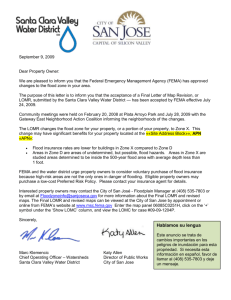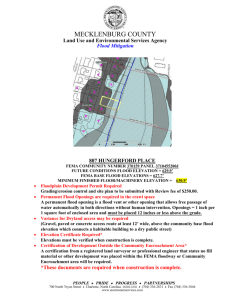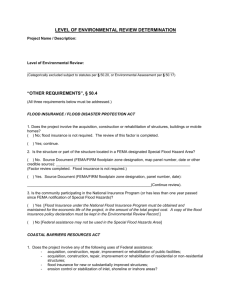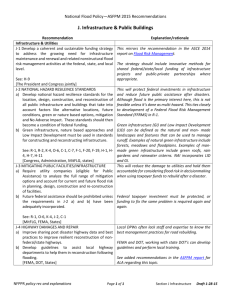FACT SHEET:
advertisement
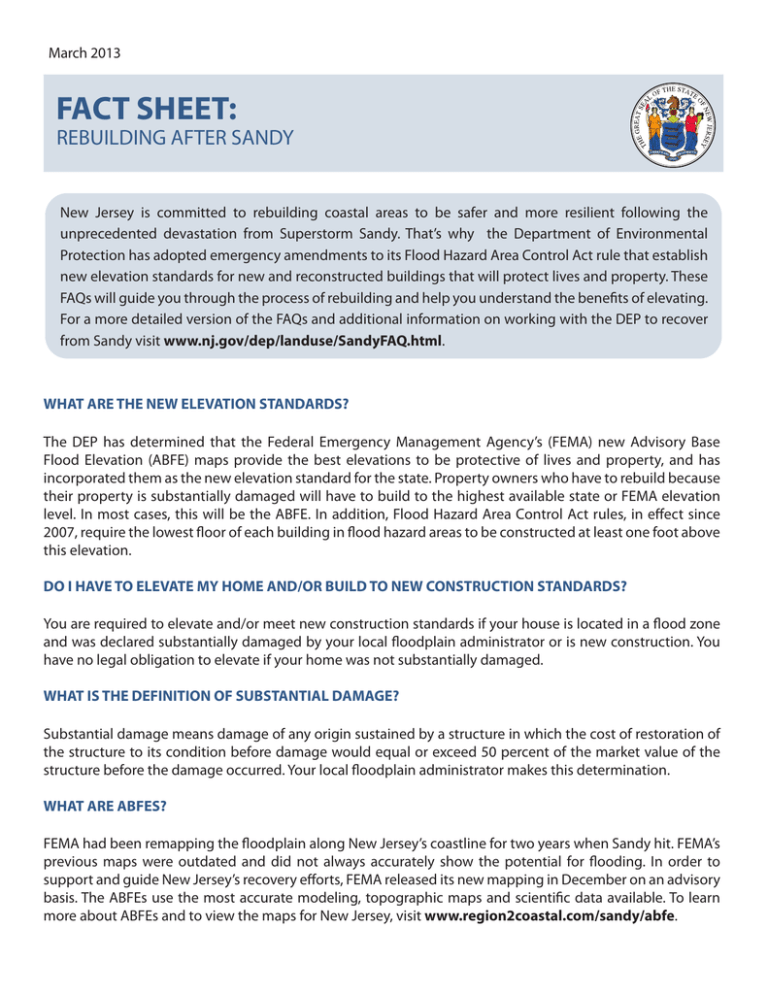
March 2013 FACT SHEET: REBUILDING AFTER SANDY New Jersey is committed to rebuilding coastal areas to be safer and more resilient following the unprecedented devastation from Superstorm Sandy. That’s why the Department of Environmental Protection has adopted emergency amendments to its Flood Hazard Area Control Act rule that establish new elevation standards for new and reconstructed buildings that will protect lives and property. These FAQs will guide you through the process of rebuilding and help you understand the benefits of elevating. For a more detailed version of the FAQs and additional information on working with the DEP to recover from Sandy visit www.nj.gov/dep/landuse/SandyFAQ.html. WHAT ARE THE NEW ELEVATION STANDARDS? The DEP has determined that the Federal Emergency Management Agency’s (FEMA) new Advisory Base Flood Elevation (ABFE) maps provide the best elevations to be protective of lives and property, and has incorporated them as the new elevation standard for the state. Property owners who have to rebuild because their property is substantially damaged will have to build to the highest available state or FEMA elevation level. In most cases, this will be the ABFE. In addition, Flood Hazard Area Control Act rules, in effect since 2007, require the lowest floor of each building in flood hazard areas to be constructed at least one foot above this elevation. DO I HAVE TO ELEVATE MY HOME AND/OR BUILD TO NEW CONSTRUCTION STANDARDS? You are required to elevate and/or meet new construction standards if your house is located in a flood zone and was declared substantially damaged by your local floodplain administrator or is new construction. You have no legal obligation to elevate if your home was not substantially damaged. WHAT IS THE DEFINITION OF SUBSTANTIAL DAMAGE? Substantial damage means damage of any origin sustained by a structure in which the cost of restoration of the structure to its condition before damage would equal or exceed 50 percent of the market value of the structure before the damage occurred. Your local floodplain administrator makes this determination. WHAT ARE ABFES? FEMA had been remapping the floodplain along New Jersey’s coastline for two years when Sandy hit. FEMA’s previous maps were outdated and did not always accurately show the potential for flooding. In order to support and guide New Jersey’s recovery efforts, FEMA released its new mapping in December on an advisory basis. The ABFEs use the most accurate modeling, topographic maps and scientific data available. To learn more about ABFEs and to view the maps for New Jersey, visit www.region2coastal.com/sandy/abfe. SHOULD I WAIT TO SEE IF THE ABFE MAPS CHANGE BEFORE REBUILDING? Deciding when to rebuild is entirely up to you. FEMA anticipates some changes to the ABFE maps for both elevations and zones and plans to release updated flood maps later this year. These revisions will further fine-tune coastal flood elevations as well as areas that are in A-zones and V-zones. The federal government’s regulatory process to finalize the maps could take up to two years. DEP will continue to work with FEMA to provide input on these maps. WHAT HAPPENS WHEN FEMA FINALIZES THE FLOOD MAPS? Your flood insurance premiums are likely to increase, in some cases significantly, depending on how your building’s floor elevation compares to FEMA’s final flood elevation. The higher you elevate now, the lower your premiums will be in the future. For example, reconstructing or elevating a $250,000 building in an A-zone so that its lowest floor is three feet above FEMA’s final flood elevation will cost an estimated $376 a year to insure, based on FEMA actuarial tables. In comparison, the same building situated three feet below this elevation could cost $7,204 a year to insure. WHAT’S THE DIFFERENCE BETWEEN FEMA’S ZONE A AND ZONE V? Both zones lie within FEMA’s 100‐year floodplain. V-zones apply only in tidal floodplains and denote hazards associated with storm‐induced waves of at least three feet in height. Construction standards in the V‐zone are more stringent in order to account for the increased risk of damage from storm surges. WHAT DO I DO IF I DON’T AGREE WITH A V-ZONE DESIGNATION OR ADVISORY BASE FLOOD ELEVATION DESIGNATION? While there is no appeal process for the ABFEs, you may appeal FEMA mapping as part of the agency’s review process when flood maps are formally proposed later this year. If you don’t want to wait, you may hire an engineering consultant to calculate your design flood elevation or V-zone designation. You should note that a detailed, site-specific analysis is expensive and may not result in significant changes. Doing this independent analysis will not protect you from higher insurance premiums if the final flood map elevations are higher than the elevation you build to. WHAT’S THE BENEFIT OF ELEVATING NOW IF I’M NOT REQUIRED? In addition to ensuring that your structure and all of its contents are better protected, many property owners will find that they will recoup the cost of elevating through lower insurance premiums over a matter of years. WHEN CAN I GET STARTED? You can begin immediately. The emergency rule provides people who must rebuild and elevate a high level of confidence that they will be in compliance with the flood elevation standards that FEMA will be adopting. There is no need to wait for FEMA to formally propose flood insurance rate maps. You can get started by talking to your municipal floodplain administrator to see if your house is substantially damaged. You should also contact your municipality to see what local approvals you may need and what construction standards you have to build to. Buildings in flood zones must meet Uniform Construction Code standards that are adopted by the New Jersey Department of Community Affairs (DCA) and enforced at the local level. WHAT SHOULD I KNOW BEFORE REBUILDING? It is very important that you carefully document any repair or reconstruction project to ensure you have a record of all activities from inception to completion. Photographs and other forms of documentation should be kept before, during, and after construction. Retain all receipts, bills, surveys and construction plans. These items will help document the history of your project should you need to do so for FEMA assistance or insurance reimbursement. IF I HAVE TO ELEVATE MY HOUSE, WILL THE STATE OR FEDERAL GOVERNMENTS HELP FINANCE THE WORK? Yes. FEMA can provide up to $30,000 to cover the Increased Cost of Compliance (ICC) with federal, state and local regulations if you have federal flood insurance. In addition, the Christie Administration intends to provide grants to homeowners with substantially damaged homes to help them offset some of the costs of elevation, mitigation and renovation, and will announce the mechanism for such grants in the near future. In order to access any additional funding, FEMA requires property owners reconstruct using the best available data, which is most likely to be the ABFE. CAN I GET INCREASED COST OF COMPLIANCE ASSISTANCE TO ELEVATE MY HOME EVEN IF IT WAS NOT DETERMINED TO BE SUBSTANTIALLY DAMAGED? This FEMA assistance is only available to those who had National Flood Insurance Program protection for structures that have sustained substantial damage and were below the current base flood elevations. It is available to anyone with flood insurance, regardless of whether the house is a primary place of residence or not. The state is exploring other options to assist property owners who want to elevate but did not meet the threshold for a determination of substantial damage. IF MY HOME IS DETERMINED TO BE SUBSTANTIALLY DAMAGED, CAN I STILL LIVE IN IT UNTIL I ELEVATE? Homeowners may live in structures that are deemed substantially damaged for up to four years before needing to elevate if they can take temporary measures to make their homes habitable. The determination of habitability must be made by the local construction official. AM I ELIGIBLE FOR INCREASED COST OF COMPLIANCE FUNDING IF I TAKE UP TO FOUR YEARS TO ELEVATE MY HOUSE? Yes, provided you were insured under the National Flood Insurance Program and you elevate in accordance with applicable standards and FEMA regulations. DO I HAVE TO ELEVATE MY HOUSE AND/OR BUILD TO NEW CONSTRUCTION STANDARDS IF MY MUNICIPALITY DOES NOT PASS AN ORDINANCE ADOPTING THE ABFES? Yes, if your municipality declares your house substantially damaged and it is located in a flood hazard area, you are required to elevate and/or build to new construction standards and may begin doing so right away. The DEP, however, is encouraging municipalities to pass an ordinance adopting the ABFEs because this will make your town eligible for Increased Cost of Compliance assistance and other federal mitigation aid. The DEP has provided municipal officials with a model ordinance so they can adopt the ABFEs as the new elevation standard. WILL I NEED A STATE PERMIT TO RECONSTRUCT OR ELEVATE MY BUILDING? The DEP regulates building elevations through its Flood Hazard Area Control Act rule. Under the changes to the rule, you are eligible for what is known as a permit by rule (effectively an automatic permit) as long as the lowest floor is elevated to at least one foot above the state’s design flood elevation and provided the building stays within its original footprint. Slight variations in size and location can sometimes be allowed. You will still need to secure local construction permits. A state Coastal Area Facility Review Act (CAFRA) permit is not needed if you reconstruct in place. Information compiled and prepared by the New Jersey Department of Environmental Protection, New Jersey Department of Community Affairs and Federal Emergency Management Agency.

